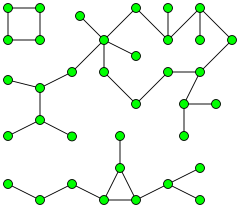分量 (图论)
在图论中,分量又称为连通分量、元件、或分支[1],是一个无向子图,在分量中的任何两个顶点都可以经由该图上的边抵达另一个顶点,且没有任何一边可以连到其他子图的顶点。例如右图中的无向图可以分成3个无向子图,也就是3个分量。没有与任何其他顶点相连的单一顶点也可以算是一个分量。
如果图是一个有向图,而每2个顶点都存在可以来回该顶点的路径则称为强连通分量;而若图上任两个点之间皆有不止一条路径连通,则称为双连通分量。
定义与示例
无向图的连通分量的定义是一个连通子图,且其不是某个更大的连通子图的一部分。例如,第一幅图有三个分量。图的每个顶点 属于一个该图的分量,其同时也是 可到达的顶点所构成的集合的导出子图。[2]每个图都是它的分量构成的不相交并。[3] 更多示例包括如下特殊情况:
- 在空图中,每个顶点形成一个有一个顶点和零条边的分量。[4] 更加一般地说,任意图中的每个孤立顶点都会形成这种分量。[5]
- 在连通图中,有且仅有一个分量,它就是整个图。[4]
- 在森林中,每个分量是一棵树。[6]
- 在聚类图中,每个分量是一个极大团。这些图可以作为任意无向图的传递闭包产生,对于这些图来说,找到传递闭包是确定连通分量的等价表述。[7]
分量的另一个定义涉及定义在图的顶点上的等价关系的等价类。在无向图中,如果有一条从 到 的路径,那么顶点 就“可到达” 。
可达性是一种等价关系,因为:
- 它是自反关系。从任何顶点到它本身都有一条长度为零的平凡路径。
- 它是对称关系。如果有一条从 到 的路径,同样的边以相反的顺序形成一条从 到 的路径。
- 它是传递关系。如果有一条从 到 的路径和一条从 到 的路径,这两条路径可以串联起来,形成一条从 到 的路径。
这种关系的等价类将图的顶点划分为不相交集,即顶点的子集,这些子集相互之间都是可达的,在这些子集之外没有额外的可达对。每个顶点正好属于一个等价类。那么,分量就是这些等价类中的每一个所形成的导出子图。[8]另外,有些资料将分量定义为顶点的集合,而不是它们所导出的子图。[9]
参见
- 强连通分量
参考文献
- ^ Diestel. 图论 (PDF). (原始内容存档 (PDF)于2019-05-03).
- ^ Clark, John; Holton, Derek Allan, A First Look at Graph Theory, Allied Publishers: 28, 1995 [2022-11-06], ISBN 9788170234630, (原始内容存档于2022-01-08)
- ^ Joyner, David; Nguyen, Minh Van; Phillips, David, 1.6.1 Union, intersection, and join, Algorithmic Graph Theory and Sage 0.8-r1991, Google: 34–35, May 10, 2013 [2022-11-06], (原始内容存档于2016-01-16)
- ^ 4.0 4.1 Tutte, W. T., Graph Theory, Encyclopedia of Mathematics and its Applications 21, Reading, Massachusetts: Addison-Wesley: 15, 1984 [2022-11-06], ISBN 0-201-13520-5, MR 0746795, (原始内容存档于2022-01-07)
- ^ Thulasiraman, K.; Swamy, M. N. S., Graphs: Theory and Algorithms, John Wiley & Sons: 9, 2011 [2022-11-06], ISBN 978-1-118-03025-7, (原始内容存档于2022-01-07)
- ^ Bollobás, Béla, Modern Graph Theory, Graduate Texts in Mathematics 184, New York: Springer-Verlag: 6, 1998 [2022-11-06], ISBN 0-387-98488-7, MR 1633290, doi:10.1007/978-1-4612-0619-4, (原始内容存档于2022-01-08)
- ^ McColl, W. F.; Noshita, K., On the number of edges in the transitive closure of a graph, Discrete Applied Mathematics, 1986, 15 (1): 67–73, MR 0856101, doi:10.1016/0166-218X(86)90020-X
- ^ Foldes, Stephan, Fundamental Structures of Algebra and Discrete Mathematics, John Wiley & Sons: 199, 2011 [2022-11-06], ISBN 978-1-118-03143-8, (原始内容存档于2022-01-07)
- ^ Siek, Jeremy; Lee, Lie-Quan; Lumsdaine, Andrew, 7.1 Connected components: Definitions, The Boost Graph Library: User Guide and Reference Manual, Addison-Wesley: 97–98, 2001
- Hopcroft, J.; Tarjan, R., Algorithm 447: efficient algorithms for graph manipulation, Communications of the ACM, 1973, 16 (6): 372–378, doi:10.1145/362248.362272
- Lewis, Harry R.; Papadimitriou, Christos H., Symmetric space-bounded computation, Theoretical Computer Science, 1982, 19 (2): 161–187, doi:10.1016/0304-3975(82)90058-5
- Reingold, Omer, Undirected connectivity in log-space, Journal of the ACM, 2008, 55 (4): Article 17, 24 pages, doi:10.1145/1391289.1391291
- Shiloach, Yossi; Even, Shimon, An on-line edge-deletion problem, Journal of the ACM, 1981, 28 (1): 1–4, doi:10.1145/322234.322235
